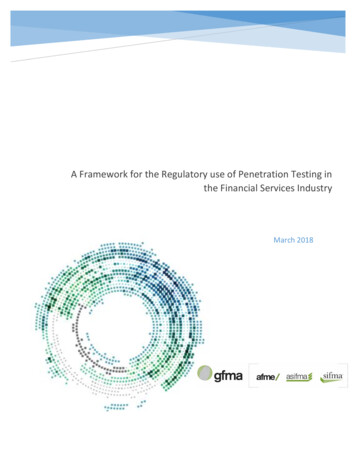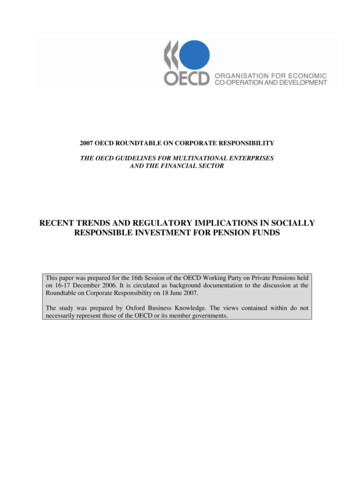
Transcription
Risk & Regulatory Academy 2020
DAY 4IRRBB, FRTB, IBOR 2020DeloitteDeloitte Central Europe 2020Risk & Regulatory Academy11
AgendaIRRBB - a new perspective to interest rate risk in the banking book IRRBB Regulatory requirements IRRBB current market conditions IRRBB Survey – Central and Eastern EuropeAlix Tchana TchanaRisk & Regulatory Directorat Deloitte FranceFRTB - The complexity of market risk in a volatile environment Client Survey from 2019: What are the biggest challenges with gettingready for FRTB SA? Standardised Readiness for CRR II An Holistic Approach to Preparing for SA Go-Live Case Study and Capital AllocationIBOR – transition to a new reality Genesis and scope of changes related to the IBOR Reform Key results of the IBOR Reform 2020 DeloitteThomas LudsteckRisk & Regulatory Senior Managerat Deloitte UKPawel SplawskiRisk & Regulatory Leaderat Deloitte Poland2
IRRBBA new perspective to interest rate risk in the bankingbook
IRRBB regulatory requirements4
IRRBB and Regulatory requirementsRegulatory milestones2004BCBS: “IRR Principles”Publication of the results ofthe BCBS consultation onthe revision of the 1997principles on the treatmentof interest rate risks in boththe trading and the bankingbook (based on theconsultation of 1993): Principles (1 – 13) oninterest rate riskmanagement in the twobooks2006CEBS: “Principles”Publication of a technicalspecification on the IRRBBby CEBS, on the basis ofthe CEBS guideline ofJanuary 2006 on thetreatment of Pillar-1 andPillar-2 risks: Principles (1 – 4) for theInstitution Principles (5 – 9) forSupervisors Principles (14 – 15) oninterest rate riskmanagement in thebanking book 2020. For information, contact Deloitte Central Europe2014EBA: SREPPublication of the EBA’sSREP guidelines: EBA’s opinion on thetreatment of the interestrate risks in the bankingbook National supervisoryauthorities as primaryaddresses of regulation Institutions to be subjectto the EBA requirementsthrough the nationalsupervisors2015EBA: Guideline BCBS: ConsultationPublication of twodocuments on themanagement of the IRRBB: EBA guidelines: Revision andextension The CEBS“Principles” BCBS consultation paper: Revision of the IRRprinciples Minimum funding forIRRBB or “hard Pillar2 approach”ExpectedimplementationdateDec 31, 2017Implementationof BCBS standardsJan 1, 2016Implementation of the EBA guidelines20162018June 30 2019BCBS: StandardsPublication of the final standardsfor IRRBB: Consideration f IRRBB in theframework of the extendedPillar 2 approach (hard pillar 2) Specification of Supervisoryrequirements for themeasurement, ManagementMonitoring as well ascontrolling of IRRBBPublication of EBA/GL/2018/02 onIRRBB: updated guidelines on themanagement of interest rate riskarising from non-trading bookactivities No explicit coverage of creditspread risks in the bankingbook (CSRBB) in CRRII, but it is afocus of the BCBS standards onIRRBB5
IRRBB and Regulatory requirementsKey takeaway A robust risk management framework for IRRBBIRRBB included in the risk appetite statement and the risk profilePolicies and procedures for limiting and controlling IRRBB – these to be reviewed at least annually and revised as requiredSpecification of delegated powers, line of responsibility and accountabilityClearly defined limits monitoring function and remediation processes when limits are breachedDefinition of authorised instruments, hedging strategies and risk taking opportunitiesIndependent evaluations of internal controls systems and risk management frameworks, including internal or external auditreview Approval of significant hedging or risk management activities Identification of IRRBB in products and activities, particularly in relation to new products or activities Integration of IRRBB risk management within the bank’s broader risk management framework Measurement of IRRBB should be based on both economic value and earnings-based measures Implement effective stress testing framework to assess the impact of IRRBB using a wide range of regulatory prescribed andinternally defined historical or hypothetical stress scenarios Documentation of key behavioural and modelling assumptions including materiality assessment, testing of assumptions,sensitivity analyses for key assumptions Ensure measurement systems and data integrity through identification and quantification of major sources of IRRBB,documented data management and sign-off process, automation where possible to minimise risk of error and robust controlframework around processes which are executed manually Independent validation and review process of IRRBB models Include all material exposure especially non performing exposure Documentation of transaction transfer between trading and banking books Consider the impact of IRRBB on capital adequacy on a forward looking basis Perform reverse stress tests to understand vulnerabilities and scenarios that severely threaten capital and earnings Implement effective stress testing framework to assess the impact of IRRBB using a wide range of regulatory prescribed andinternally defined historical or hypothetical stress scenarios Capital adequacy for IRRBB under a wide range of factors and document this in the ICAAP. Key considerations include: capitalbuffers against loss of earnings, if applicable, assessments of capital associated with lines of business and associated capitalallocation Implementation of outlier test based on EVE under 6 prescribed scenarios 2020. For information, contact Deloitte Central Europe6
IRRBB and Regulatory requirementsIRRBB implementation challengesDynamic Analysis & StressScenarios for Models andMethodsImplement robust riskmanagement frameworkaround IRRBB models There is a sophistication of risk measurement that should be commensurate with natureand scale of activities Measuring impact of IRRBB on both earnings and economic value measures Six interest rate shocks scenarios to implement Stress tests, EV / NII Simulations, dynamic balance sheet projections are needed in thenew IRRBB framework IRRBB IT systems need to be enhanced. In particular, external vendor solutions used bymany institutions for projections, FTP and NII computation Behavioural models need to interest rate sensitive The new IRRBB framework heightened scrutiny of behavioural models and IRRBBindicators Risk and treasury functions need to be co-ordinated to avoid overlaps since IRRBB isoften seen as a risk management technique rather than a “trading” one The IRRBB framework increases overheads and pressure on validation functions that arealready overstretched. Smaller banks may not have independent model validation or therequisite knowledge Introduction of dynamic perspective will require a greater cooperation among RiskManagement, ALM and Planning & Forecasting departments on both the definition of acoherent operating model and the implementation of an IT integrated solution.New target operatingmodel for ALM functions Dynamic analyses will require forecasting the future production but also the commercialmargin targets, in coherence with the bank’s strategic and business planning. In order toproperly analyze all effects of the changes in interest rates and of balance-sheetstructure, the granularity of forecasts should be consistent with that of modelling(generally, at product level). 2020. For information, contact Deloitte Central Europe7
IRRBB and Regulatory requirementsFocus on ICAAP ICAAP (internal capital adequacy assessment process) is within pillar 2 of Basel regulation.For Credit and market risk, it a complement to pillar 1 requirements. For IRRB, Capital requirement is driven by the supervisory outlier test and ICAAPDefinitionSource: ECB Two main issues:ChallengesencounteredIRRBB measurementRelationship between normative and economic perspective“Another issue observed concerns the quantificationof IRRBB, where one-half of the banks use either acombination of earnings and EVE measures or a pureearnings concept to quantify their IRRBB under theeconomic perspective.”“Focusing on single risk categories, the information from theeconomic to the normative perspective is more often usedfor certain risks (e.g. credit and market risk) than for others(e.g. operational risk and interest rate risk in the bankingbook (IRRBB)).”Source: ECB 2020. For information, contact Deloitte Central EuropeSource: ECB8
IRRBB and Regulatory requirementsICAAP – Feedback on ECB survey (1/2)Context The ECB analysis concern ICAAP framework (all risk classes included) The analysis is performed on 37 financial institutions, all GSIB’s and it is basedon the ICAAP packages submitted in April 2019.ResultsIn average three sub-categories of risk are considered byEuropean banks for IRRBB: Gap risk Basis risk Option risk 2020. For information, contact Deloitte Central EuropeFew banks integrate a relationship betweeneconomic and normative perspective.9
IRRBB and Regulatory requirementsICAAP – Feedback on ECB survey (2/2)Results Around one-quarter of the banks in the sample usestatistical models that focus on economic value of equity(EVE) measures. Overall, one-half of the banks use some kind ofcombination of EVE and earnings measures fordetermining risk figures under the economic perspective One in ten banks only quantifies earnings measures. 2020. For information, contact Deloitte Central Europe For IRRBB, the majority of banks use scenario analysisand statistical models. One-third of the banks use supervisory outlier testfigures, respectively, without any amendments. Approximately one in ten banks integrates IRRBB risk inmarket risk.10
IRRBB new challenges11
IRRBB within low interest rate contextIn the context of low interest rates, European banksprofitability has been weakened. Transformation margin (short term refinancing vs longterm loans) is low since the interest rate curve flattens Client behavior is evolving and more and more dynamicNet Interest Income (NII) has been particularly impacted inthis environment.Consequently, European banks are searching for newrooms of profitability through: Projections of NII under multiple business and marketscenarios Improve the quality of IRRBB measures (accuracy of theindicators and data quality) Greater implication of ALM within the sales processand the budget forecasting 2020 Deloitte121
IRRBB current challengesBehavioral modelDynamic balance sheet and NII projectionsData QualityBuild more comprehensivebehavioral model to capturedependency with interest rateand the structural changesPerform in a reasonable timeframe balance sheetand NII projection when making assumptions onnew business volume and interest rate scenarios Banks are facing IT systems limitations andweakness of the organization (interactionbetween Management Control departmentand ALM)Exhaustiveness and actualityare the main issues encountered13 2020 Deloitte13
IRRBB SurveyCentral and Eastern Europe14
Deloitte IRRBB survey – Central and Eastern EuropeContextIn which country is the bank located?How big are the bank’s total assets and what is thebank’s SREP category?In 2019 Deloitte asked Central andEastern European banks toparticipate in a survey regarding ALMsolutions applied. Risk estimation andmeasurementRole of ALM units in banksPoland 15Czech Republic 1Slovakia 2#BANKSThe survey consisted of open andclosed 53 questions aimed atevaluation of current ALM practicesadopted on the market. Thequestions focusedon the following areas:201510Hungary 3Bosnia and Herzegovina 4Serbia 5Macedonia 1Bulgaria 1Albania 15001234EU SREP CATEGORY567The size of the field reflects the sum of assets in the ranges: EUR 0-1 bn, EUR 1-5 bn, EUR 5-20 bn,EUR 20-45 bn, above EUR 45 bn 2020 Deloitte151
Deloitte IRRBB survey – Central and Eastern EuropeResponsibilities around balance sheet forecast For the purposes of balance sheetdevelopment scenarios, most banks use dataprepared by their business units (in particularnew sales value and planned margins in allbank groups, or advance payments and clientoptions in non EU banks) In all groups of banks risk is the key factormodelling risk related costs. Planning advancepayments and client options are next factorsconsidered. Finance units usually plan non interest incomeand expense. Further, they plan the new salesvalue and margins. ALM units participate in the development ofmarket scenarios regarding liquidity andinterest rate. This role may be performed byother units, such as risk or finance (forliquidity), or chief economist (for interest rate). 2020 Deloitte16
Deloitte IRRBB survey – Central and Eastern EuropeResults – IRRBB measuresWhich measures are used to measure interest rate risk: Most surveyed banks used both measuresindicated in the EBA 2018/02 guidelines,i.e. NII and EVE.Number of respondents3Net interest income (NII) simulation3101427Economic value of equity (EVE)simulation391325BPV27VaR28Modelled interest rate gap in staticterms36Contractual interest rate gap instatic terms25Modelled interest rate gap indynamic terms24Contractual interest rate gap indynamic terms1 EVE is still less popular, though. Along with these two measures, bankscontinued using more traditional ones tomeasure IRRBB, such as BPV, VaR or gapmodelling.12189757233181714141725Other include: client behaviour risk, convexity risk, EVE NII, EaR/EVE 2020 DeloitteCEELeadersChallengersPack17
Deloitte IRRBB survey – Central and Eastern EuropeResults – IRRBB measuresWhat assumptions related to the balance sheet are included in the IRRBB measures?Number of respondents3Static balance sheet3Dynamic balance sheet3Commercial margin consistent with interest rate scenario2Business flows dependent on interest rate environments21218833149252414431027Which cash flow modelling approach does the Bank follow?Number of respondents3UnconditionalPartially or fully conditional 2020 Deloitte121833119CEE3314197LeadersChallengersPack
Peers / Market. Lead the design and issuance of RFR-linked products. Bank Associations (ABA, EBF, IIF ) Development of protocols, standards and fallback language. Market Associations (ISDA, LMA, IMA ) Clearing Houses (LCH, EUREX, ME ) Key role in











